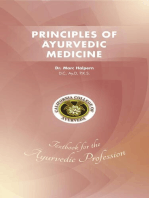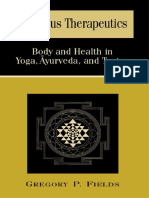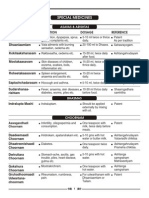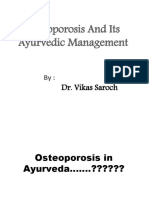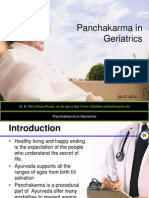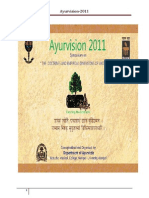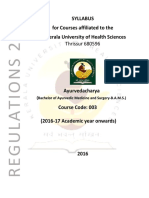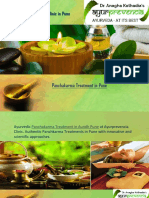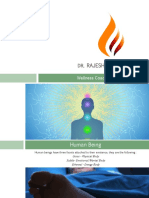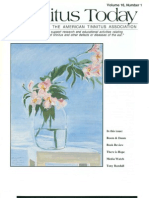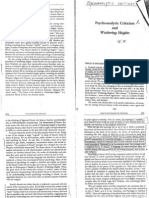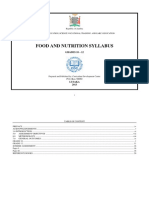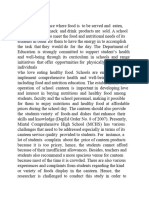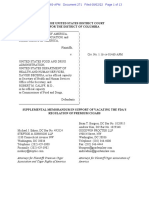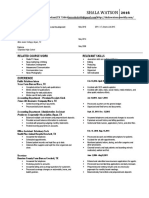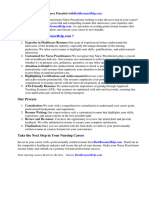Rasayana
Rasayana
Uploaded by
Rajesh NanooOriginal Description:
Copyright
Available Formats
Share this document
Did you find this document useful?
Is this content inappropriate?
Report this DocumentCopyright:
Available Formats
Rasayana
Rasayana
Uploaded by
Rajesh NanooCopyright:
Available Formats
WORLD JOURNAL OF PHARMACY AND PHARMACEUTICAL SCIENCES
Mishra et al. World Journal of Pharmacy and Pharmaceutical Sciences
SJIF Impact Factor 5.210
Volume 4, Issue 06, 377-387. Review Article ISSN 2278 4357
THE AYURVEDIC PERSPECTIVE OF RASAYANA A REVIEW
Dr. Sriram Chandra Mishra1*, Dr. Anil Kumar Singh2, Dr. Jagadish Prasad Mishra3,
Dr. Kalanidhi Hota4
1,2
Associate Professor, PG Dept of Kayachikitsa, VYDS Ayurved Mahavidyalaya, Khurja
(UP).
3
Assistant Professor, Dept of Shalakya tantra, VYDS Ayurved Mahavidyalaya, Khurja (UP).
4
Assistant Professor, PG Dept of Shalya tantra, VYDS Ayurved Mahavidyalaya, Khurja (UP).
ABSTRACT
Article Received on
11 April 2015, Everyone wants to maintain young and healthy life-span forever but
Revised on 01 May 2015, the natural phenomenon of undesirable changes is the inevitable phases
Accepted on 22 May 2015
of human life. The changes are always degenerative in nature. So it is
necessary to rejuvenate the body systems for a better harmony of the
*Correspondence for Body, Mind and Soul. Ayurveda helps in Maintaining health,
Author Prevention of diseases and also avoid the recurrence of diseases. It
Dr. Sriram Chandra counters the aging and its allied ill-effects with three approaches. First
Mishra
it recommends Vayasthapak drugs (age stabilizers) to counter the
Associate Professor, PG
aging and its adverse effects, secondly by using Jeevaneeya group of
Dept of Kayachikitsa,
VYDS Ayurved herbs (Vitalisers) to rejuvenate the aged body and third by Rasayana
Mahavidyalaya, Khurja therapy (rejuvenative process and formulations) for Jarachikitsa (old
(UP). age care). The main purpose of Rasayana therapy is to impede the
aging process and to delay the degenerative process in the body in
terms of special herbs, fruits or any other form of medication that are known to promote
positive health and longevity.
KEYWORDS: Rasayana (Rejuvenation Therapy), Vayasthapak (Age stabilizers), Jeevneeya
(Vitalisers), Jarachikitsa (Geriatric disorder management).
INTRODUCTION
The world population is rapidly ageing due to over exertion and hectic life style physical as
well as mental. Day by day the people feel insecure which increase stress. The faulty diet like
fast foods, preservatives etc, addiction of alcohol, smoking etc, lack of exercise, use of too
www.wjpps.com Vol 4, Issue 06, 2015. 377
Mishra et al. World Journal of Pharmacy and Pharmaceutical Sciences
much television, mobile phones, computers etc also enhances the problem. All these factors
decrease the normal Dhatu, Ojas etc and vitiate all Doshas resulting in premature aging,
fatigue, recurrent illness, depression etc. This became the special health challenges of old-age
care for the 21st century. Ayurveda, since its inception, has a very well developed branch,
among eight branches, for the management of Geriatrics disorders entitled Jarachikitsa and
elaborates Rasayana (Rejuvenation) which deals with the problems related to ageing and
methods to counter the same. Ayurvedic literature record numerous single and compound
plant based medicines, herbo-mineral, herbo-metalic formulations for general well being and
in disease specific conditions relating to geriatrics. Rasayana also elaborated in Rig-Veda and
Atharva-Veda for Gods like Soma etc to resists fire, water and various weapons (Rig-Veda
5/1/7, Atharva-Veda 16/2/2). Rasayana basically boosts the Oja (vital force of life - the
immune system) and helps the person to maintain good health. Rasayana Chikitsa is also
known as Rejuvenation Therapy.
What is Rasayana?
The term Rasayana is formed by union of two words[1] Rasa and Ayana. The word
Rasa in this context means the first liquid tissue, the Rasadhatu, which nourishes all the
tissues in the body and the word Ayana is its circulation. As per Ayurveda if rasadhatu is
produced in optimum quality and quantity, then naturally all the tissues in the body will be
nourished properly. So literally the technical term Rasayana refers to the means of obtaining
the optimum nourishment to the Dhatus. Hence Rasayana or rejuvenation is such a form of
treatment in which all the tissues are nourished and enhanced. The nourishment of vital
tissues helps in stopping old age.
Rasayana drugs are those which invigorate a healthy person by producing the best quality of
Rasa, Rakta etc dhatus[2] and also which decreases the aging process, increases the longevity,
increases the mental as well as physical strength and which destroys the disease process [3].
According to Maharsi Dalhana Vayahsthapanam Varsha-Shatayuh-Sthapanam i.e. enabling a
person to complete his normal life span of 100 years. Anye Tu Vayah-Sthapanm Jara-
Apaharanam, Tarunyam Bahu-Kalam Sthapyati-Iti-Arthah i.e. Rasayana prevents aging thus
establishes youth for a longer period[4]. Chakrapani defined that if Rasayana taken by healthy
persons it bestows strength to the ojus and dhatus of the body. [5] Gangadhara roy in his
commentary jalpakalpataru defined that the therapy which prevents jara (old age itself is
disease) as Rasayana.[6]
www.wjpps.com Vol 4, Issue 06, 2015. 378
Mishra et al. World Journal of Pharmacy and Pharmaceutical Sciences
Classification of Rasayana
There are various classifications for Rasayana therapy. Some of them are as follows-
Primarily of two types
I. Dravabhuta Rasayana - Dravya means substance hence the rasayan therapy where
various substances like herbs, minerals, foods etc used is known as Dravyabhuta Rasayana.
II. Adravabhuta Rasayana - Adravya consequently means where no substance is used hence
when modalities like good behaviour, meditation etc are used its called as Adravya Rasayana.
Example is Achara Rasayan.
According to scope
I. Kamya Rasayana[7] (Kamya - desire) - It is used to serve a special purpose or to serve a
special purpose. They can be further divided in following types
Pranakamya Promoter of vitality and longevity. Example - Amalaki, Haritaki, Guduchi,
Shatavari etc.
Medhakamya Promoter of intelligence and memory. Example - Brahmi, Mandukaparni,
Jyotishmati, Jivanti etc.
Srikamya Promoter of complexion. Example - Guduchi, Bhringaraja, Amalaki, Triphala,
Ashvagandha etc.
II. Naimittika Rasayana The Rasayana used to promote the health of a particular tissue or
system or to prevent their disorders is known as Naimittika Rasayan. Examples
Prameha: Haridra, Shilajatu, Amalaki etc
Amavata: Bhallataka, Lashuna, Pippali etc
Nervous Disorders: Bala, Nagbala etc
Skin Diseases: Tuvaraka, Guduchi, Bhringaraja etc
Urinary Tract: Gokshuru, Punarnava. Shilajatu etc
Gastro-Intestinal System: Amalaki, Haritaki, Guduchi, Vidanga (worms), Shatavar (also
lactogaugue) etc
Vata Vyadhi Shilajith, Gugulu, Chyavanaprasha, Abhayamalaka ch:chi:28 etc
Pandu- Yogaraja Rasayana, Loha, Shilajith ch:chi:26 Abhayavaleha ch:chi:16 etc.
III. Ajasrika Rasayana It is the using of food substances on regular basis for
nourishment of body. Examples are daily usage of cows milk, ghee etc.
www.wjpps.com Vol 4, Issue 06, 2015. 379
Mishra et al. World Journal of Pharmacy and Pharmaceutical Sciences
According to drug, diet and life style
I. Aushadha Rasayana - Based on drugs and herbs
II. Ahara Rasayana - Based on diet and nutrition
III. Achara Rasayana - Based on conduct and Behaviour / Lifestyle. Keeping cool mind,
avoiding misuse of alcohol & sex, nonviolent and calm behaviour, Sweet by speech, having
lot of patience, generous, preferring cleanliness, sincere, worshipping gods and teachers,
sensible, having equal sleep & work, egoless, well-Mannered, spiritual, serving elderly
people, preferring religious sayings are some examples of this.
According to administration[8]
I. Kuti-praveshika Rasayana Kutipraveshika is made up of two words i.e. Kuti meaning
A hut or cottage[9] and Praveshika means To enter[10]. Hence in this form of Rasayana
therapy, the person is made to stay in a specially designed chamber for a certain period and is
given Rasayana preparations (Non-ambulatory method/ In -door therapy). Before taking this
form of rejuvenation therapy, the person has to undergo Panchakarma therapy. [11]
II. Vatatapika Rasayana This is the Ambulatory method also called as Open air therapy or
outdoor therapy [12]. This is rightly indicated in the name Vatatapika, where Vata means
[13]
air , and atapa means heat or sun[14]. So this is a method of taking Rasayana, while a
person remains exposed to air and heat and this type can be taken while working and doing
normal routine work.
Examples of Rasayanas used in this methods are Chyavanaprasha[15], Amalaka Rasayana[16],
Haritaki Rasayana[17], Pippali Rasayana[18], Vidanga Rasayana[19], Triphala Rasayana[20],
Shilajitwadi Rasayana[21] etc.
Some special Rasayanas
Vardhaman Rasayana[22]: Vardhamana means in increasing order. Hence the Rasayana
in which the dosage is increased periodically then reduced periodically is called Vardhamana
Rasayana. This is generally done for improving immunity of certain organs or channels with
herbs like Piper longum or Pippali etc.
Medhya Rasayana[23]: Medhya Rasayanas are group of medicinal plants described in
Ayurveda with multi-fold benefits, specifically to improve memory and intellect by Prabhava
(specific action). It also provides immunity against diseases, strength, complexion, voice and
www.wjpps.com Vol 4, Issue 06, 2015. 380
Mishra et al. World Journal of Pharmacy and Pharmaceutical Sciences
digestive capacity. The special herbs used include swarasa (juice) of Mandukaparni (Centella
asiatica Linn), the churna (powder) of Yastimadhu (Glycirrhiza glabra Linn.) in milk, the
swarasa (juice) of all parts (roots, stem and flowers) of Guduchi (Tinospora cordifolia (Wild)
Miers) and kalka (paste) of Shankhapushpi (Convolvulus pleuricaulis Chois). Yet in practice
few more handful drugs used with same aim are mentioned elsewhere in the Ayurveda
classical textbooks.
Table 1: Properties of different Medhya ausadhi[24]
Drug Rasa Guna Virya Vipaka
Mandukaparni Tikta Laghu Sita Madhur
Yastimadhu Madhur Guru, Snigdha Sita Madhur
Guduchi Tikta, Kasaya Guru, Snigdha Usna Madhur
Shankhapushpi Tikta Snigdha, Picchil Sita Madhur
Aindri Tikta Laghu Usna Katu
Jyothishmati Katu, Tikta Tikshna Usna Katu
Kushmanda Madhur Laghu, Snigdha Sita Madhur
Vacha Katu, Tikta Laghu, Tikshna Usna Katu
Jatamamsi Tikta, Kasaya Madhur Laghu, Snigdha Sita Katu
[25]
Astavarga Herbs - The eight herbs mentioned below constitute the
Jeevaneeyagan[26,27] (vitalisers). These herbs are aphrodisiac, strengthening, blood
purifier, conception plus and galactogogue. Collectively these herbs are also named as
Astavarga. As the original herbs have become extinct, the substitute herbs are in use
today.
1. Jeevak - SubstituteVidarikand (Pueraria tuberose)
2. Rishbhak Substitute... Vidarikand (Pueraria tuberose)
3. Meda - Substitute Shatawari moola (roots of Asparagus racemosus)
4. Mahameda- Substitute.. Shatawari moola (roots of Asparagus racemosus)
5. Kakoli-SubstituteAswagandha moola (Withania somnifera)
6. Ksheerkakoli SubstituteAswagandha moola (Withania somnifera)
7. Riddhi - SubstituteVarahikand (Diascorea bulbifera)
8. Vriddhi -SubstituteVarahikand (Diascorea bulbifera)
Vayasthapak drugs[28] (Age Stabilizers) - various diseases or help contribute to positive
health like age stabilization or enhancing aphrodisiac power. These herbs are listed
below.
1. Guduchi. Tinospora cordifolia
www.wjpps.com Vol 4, Issue 06, 2015. 381
Mishra et al. World Journal of Pharmacy and Pharmaceutical Sciences
2. Haritiki. Terminalia chebula
3. Amalki. Emblica officinale
4. Yukta. Pluchea lanceolata
5. Shweta. Clitoria ternatea
6. Jeewanti. Leptadenia reticulata
7. Atirasa. Asperagus racemosus
8. Mandookparni. Centella asiatica
9. Sthira. Desmodium gigenticum
10. Punarnava. Boerhaavia diffusa
Rasayana drugs for specific dhatus [29,30]
Rasa (Plasma) Draksha, Shatavari, Dates
Rakta (Blood) Amalki, Dhati lauha, Bhringaraj, Suvarnamakshik Bhasma
Mamsa (Muscle) Masha, Ashwagandha, Bala, Nux vomica, Silver bhasma
Meda (Fat) Guggulu, Shilajit, Haritaki, Guduchi, Garlic
Shukti (mother of pearl) bhasma, Kukkutandatwak bhasma,
Asthi (Bone)
Vamsharochana,
Majja (bone marrow) Calamus, Shankhapushpi, Loha bhasma, Gold bhasma, Makaradhwaja
Kapikacchu, Vidarikanda, Shatavari, Ashwagandha, Gold bhasma, Ghee
Sukra (Reproductive)
and Cow milk.
Rasayana for specific channel-systems[31,32]
Respiratory System Chyavanprash, Vardhaman pippli
Water Metabolism System Fresh ginger, Cyperus, Cardamom
Digestive System Long pepper, Bhallataka, Haritaki,
Circulatory System (lymphatic
Draksha, Shatavari, Dates
portion)
Circulatory System (blood portion) Amalki, Dhati lauha, Bhringaraj, Suvarnamakshik Bhasma
Muscular System Masha, Ashwagandha, Bala, Nux vomica, Silver bhasma
Adipose System Guggulu, Shilajit, Haritaki, Guduchi, Garlic
Shukti (mother of pearl) bhasma, Kukkutandatwak bhasma,
Skeletal System
Vamsharochana,
Aswagandha, Calamus, Gotukola, Shankhapushpi, Loha
Nervous System
bhasma, Gold bhasma, Makaradhwaja
Aswagandha, Kapikacchu, Sweta Mushali, Shatavari,
Reproductive System
Vidarikanda,Gold bhasma, Ghee and Cow milk.
Urinary System Punarnava, Gokshura
Excretory System Kutaj, Vidanga, Triphala
Sweat System Basil, Nux vomica
Menstrual System Ashoka, Lodhra, Shatavari
Lactation System Shatavari, Jeeraka, Milk
www.wjpps.com Vol 4, Issue 06, 2015. 382
Mishra et al. World Journal of Pharmacy and Pharmaceutical Sciences
Rasayana for senses and other organs [33,34]
Eye Triphala, Licorice, Shatavari
Nose Nasya of Anu oil
Skin Tuvarak, Catechu, Bakuchi
Brain Gotu kola, calamus
Heart Guggul, Elecampane, Gold bhasma
Neuro-Muscular System Bala, Nagbala, Garlic, Guggul
Selection of Rasayana according to age[35]
The changes of ageing are always degenerative in nature which is very beautifully quoted by
Sarangadhara. The childhood, growth, luster/beauty, intellect, luster of skin, Vision, sexual
ability, physical ability, thinking ability and locomotion starts to loss from the body with each
passing decade.
Decades of life Specific loss from the body Suitable Rasayana Drugs
Vacha (Acorus calamus)
0-10 Balya (childhood)
Kasmari (Gmelina arborea)
Bala (Sida cordifoila)
11-20 Vruddhi (growth)
Aswagandha (Withania somnifera)
21-30 Chavi (luster) Amalaki (Emblica officinalis)
Shankhapushpi (convalvulus pluricalis)
31-40 Medha (intellect)
Jyotishmati (Celestrus paniculata)
Bhringaraja (Eclipta alba)
41-50 Twak (luster of skin)
Somaraji (Centratherum anthelminthicum)
51-60 Drusti (Vision) Saptamruta loha
Atmagupta (Mucuna prurita)
61-70 Sukra (sexual ability)
Munjataka (Orchis longifolia)
71-80 Vikrama (physical ability) Bala, Amalaki
81-90 Buddhi (thinking ability) Brahmi, Sankhapuspi
91-100 Karmendriya (locomotion) Aswagandha, Bala
Rasayana drugs as per the constitution[36]
Diseases prone to suffer from Specific measure to prevent
Dryness, Hardness and roughness of the skin, Cracking of the hair,
Vata Regular intake of ghee
nails etc. Stiffness and pain in the joints, Constipation, Insomnia
Burning sensation in the body, excessive temperature, Excessive
Pitta sweating, excessive thirst, Acid eructation, Premature greying of the Regular intake milk
hair, Wrinkles
Heaviness of the body, easy weight gain, unable to lose weight,
Kapha Regular intake honey
drowsiness, Excessive sleep, Laziness, Obesity
Benefits of Rasayana Therapy[37,38,39,40]
According to various Ayurvedic classics, Rasayana therapy gives various benefits according
to its compositions. Rasayana or Rejuvenation literally means to return to youthful conditions
www.wjpps.com Vol 4, Issue 06, 2015. 383
Mishra et al. World Journal of Pharmacy and Pharmaceutical Sciences
or to normal from diseased state. It helps to promote and preserve health and to cure disease
in sick. It also increases a healthy persons mental and physical capabilities and also keeps
the body and mind pleasant. It also increases the strength of Agni as well as Prana and
removes waste products from the body.
It enhances the intelligence, memory power, will power, body strength, skin luster, sweetness
of voice, physical strength. It nourishes the Sapta dhatus and the whole body. Thus prevents
chronic degenerative changes and illness. It improves metabolic processes, physical strength
and sharpness of sense organs. It improves natural resistance against infection by increasing
Immunity power.
Things to be avoided during Rasayan therapy[41]
Anger, Violence and Jealousy, Indulgence in liquor and sex, Fatigue due to excessive strain,
Roughness in words, Cruel and sinful acts are to be avoided during use of Rasayan therapy.
These are unfit on account of respective ignorance, inactivity, poverty, vacillations,
intemperance and inability to secure the genuine medicines.
DISCUSSION
Rasayana is the term given to special herbs, fruits or any other form of medication that are in
single or compound plant based medicines, herbo-mineral, herbo-metalic formulations known
to promote general well being and in disease specific conditions relating to geriatrics. As per
our Maharsis Rasayanas are advised for peoples of above 16 years[42,43] but as we naturally
loose childhood, growth, luster/beauty, intellect, luster of skin, Vision, sexual ability,
physical ability, thinking ability and locomotion with each passing decade so to prevent
unnatural loses there is description of rasayanas for this also. The various types of Rasayana
therapy are useful for specific as well as general use of it. Both dravyabhuta and
adravyabhuta form of rasayanas are important for benefit of human being. Use of the
adravyabhuta form of rasayanas daily will gave prestigious issue in the socity also [44].
Modern research also covered a lot of pharmacological screening of most of these rasayan
herbs. The possible mechanisms by which action of Rasayana can be interpreted with modern
aspects are as follows
Immuno-modulatory action - Prevents recurrent infection, expelling the damaged cells
Adaptogenic action - Maintains the balance between mind and body
Antiaging action.- Encourages the growth of new cells
www.wjpps.com Vol 4, Issue 06, 2015. 384
Mishra et al. World Journal of Pharmacy and Pharmaceutical Sciences
Nutritive function - Nourishes and maintains the cell life
Antioxidant Action - Eliminates the toxic metabolites and pollutants.
CONCLUSION
Rasayana drugs are those medicines which are capable for Rejuvenation of the body by
imparting superior Rasas and Dhatus to the body and toning up the system of healthy persons.
The main purpose of Rasayana therapy is to impede the aging process and to delay the
degenerative process in the body, but as Jara (old age) is inevitable, it cannot be avoided, it
can only be delayed with the help of Rasayanas.
REFERENCES
1. Sanskrit Hindi Shabdkosha by Waman Aapte Page 94 , Anil Prakashan Delhi, 2007.
2. Dr. Brahmanand Tripathi, Charak Samhita, Chikitsa Sthana Chapter 1/1/5 Page.4.
Chaukhamba Surbharti Prakashan, 2007.
3. Kaviraj Ambikadutta Shastri, Sushruta Samhita, Sutra Sthana, chapter 1/4, Page 15.
Chaukhamba Sanskrit Sansthan, Varanasi, 2007.
4. Vd Jadavji Trikamji Acharya, Dalhana nibandha samgraha tika on Sushruta Samhita,
Chikitsasthana, chapter 27/1,. Chaukhamba Sanskrit Sansthan, Varanasi, 2010.
5. Dr. Kasinath Tripathy, Chakrapani tika on Charak Samhita Chikitsasthana Chapter 1/1/8.
Chaukhamba Sanskrit Sansthan, 2009.
6. Sri Narendra nath Sengupta et al, Jalpakalpataru and Ayurveda Dipika tika on Charaka
Samhita chikitsasthana Chapter 1/1/8, pg 2266, Chaukhamba orientalia, 2009.
7. Kaviraj Ambikadutta Shastri, Dalhana tika on Sushruta Samhita, Chikitsasthana, chapter
27/3-4, Page 151. Chaukhamba Sanskrit Sansthan, Varanasi, 2007.
8. Dr. Brahmanand Tripathi, Charak Samhita, Chikitsa Sthana Chapter 1/1/16 Page.9.
Chaukhamba Surbharti Prakashan, 2007.
9. Waman Aapte, Sanskrit Hindi Shabdkosha, Page 278, Anil Prakashan Delhi ,2007.
10. Waman Aapte, Sanskrit Hindi Shabdkosha, Page 668, Anil Prakashan Delhi ,2007.
11. Dr. Brahmanand Tripathi, Charak Samhita, Chikitsa Sthana Chapter 1/1/17-20 Page.10.
Chaukhamba Surbharti Prakashan, 2007.
12. Dr. Brahmanand Tripathi, Charak Samhita, Chikitsa Sthana Chapter 1/1/16 Page.9.
Chaukhamba Surbharti Prakashan, 2007.
13. Waman Aapte, Sanskrit Hindi Shabdkosha, Page 878, Anil Prakashan Delhi, 2007.
14. Waman Aapte, Sanskrit Hindi Shabdkosha, Page 147, Anil Prakashan Delhi, 2007.
www.wjpps.com Vol 4, Issue 06, 2015. 385
Mishra et al. World Journal of Pharmacy and Pharmaceutical Sciences
15. Dr. Brahmanand Tripathi, Charak Samhita, Chikitsa Sthana Chapter 1/1/62-74, Page
20-22, Chaukhamba Surbharti Prakashan, 2007.
16. Dr. Brahmanand Tripathi, Charak Samhita, Chikitsa Sthana Chapter 1/1/75, Page 23,
Chaukhamba Surbharti Prakashan, 2007.
17. Dr. Brahmanand Tripathi, Charak Samhita, Chikitsa Sthana Chapter 1/1/76-77, Page
24-25, Chaukhamba Surbharti Prakashan, 2007.
18. Dr. Brahmanand Tripathi, Charak Samhita, Chikitsa Sthana Chapter 1/3/32-35, Page 48,
Chaukhamba Surbharti Prakashan, 2007.
19. Dr. Brahmanand Tripathi, Charak Samhita, Chikitsa Sthana Chapter 1/2/9, Page 32,
Chaukhamba Surbharti Prakashan, 2007.
20. Dr. Brahmanand Tripathi, Charak Samhita, Chikitsa Sthana Chapter 1/3/41-47, Page
52-53, Chaukhamba Surbharti Prakashan, 2007.
21. Dr. Brahmanand Tripathi, Astanga Hridaya, Uttarasthana Chapter 39/161, Page 1202,
Chaukhamba Sanskrit Pratishana, 2003.
22. Dr. Brahmanand Tripathi, Charak Samhita, Chikitsa Sthana Chapter 1/3/36-40, Page 50,
Chaukhamba Surbharti Prakashan, 2007.
23. Dr. Brahmanand Tripathi, Charak Samhita, Chikitsa Sthana Chapter 1/3/30-31, Page 48,
Chaukhamba Surbharti Prakashan, 2007.
24. Medhya Dravya in Ayurveda A Critical Review, Nirmal Kumar et al / IAMJ: Volume
1; Issue 3; May June 2013.
25. Acharya Balkrishna et al, Astavarga plant threatened medicinal herbs of the north-west
Himalaya, Int. J. Med. Arom. Plants, vol -2, no 4, PP-661-676, Dec 2012.
26. Dr. Brahmanand Tripathi, Charak Samhita, Sutra Sthana Chapter 4/8 (1), Page 73,
Chaukhamba Surbharti Prakashan, 2007.
27. Sri Brahma Sankar Mishra, Bhav Prakash Nighantu, Chapter Guduchyadi Varga, Shloka
57-59. Chaukhambha Sanskrit bhawan 2010.
28. Dr. Brahmanand Tripathi, Charak Samhita, Sutra Sthana Chapter 4/8 (50), Page 98,
Chaukhamba Surbharti Prakashan, 2007.
29. http://www.charakayurveda.com/Rasayana.htm (Accessed on 26 February 2015).
30. Rasayan therapy: A magic contribution of ayurveda for healthy long life, Anil Kumar
Singh et al/ int. J. Res. Ayurveda pharm. 5(1) Jan- Feb 2014.
31. Bagde A. B. Etc, Rasayana Chikista: Antiagening Therapy Of Ayurveda, International
Research Journal Of Pharmacy, 2013; 4(4).
www.wjpps.com Vol 4, Issue 06, 2015. 386
Mishra et al. World Journal of Pharmacy and Pharmaceutical Sciences
32. Ayurvedic management of select geriatric disease conditions, Central Council for
Research in Ayurveda and Siddha, New Delhi, 2011.
33. Rasayan therapy: A magic contribution of ayurveda for healthy long life, Anil Kumar
Singh et al/ int. J. Res. Ayurveda pharm. 5 (1) Jan- Feb 2014.
34. http://www.charakayurveda.com/Rasayana.htm (Accessed on 26 February 2015).
35. Tripathy Brahmananda, Sharangadhar Samhita, purvakhanda, chapter 6 sloka 19,
Chaukhambha Surabharati Prakashana (1996).
36. Vd Jadavji Trikamji Acharya, Dalhana nibandha samgraha tika on Sushruta Samhita,
Chikitsasthana, chapter 27/6,. Chaukhamba Sanskrit Sansthan, Varanasi, 2010.
37. Dr. Brahmanand Tripathi, Charak Samhita, Chikitsa Sthana Chapter 1/1/7-8, Page 5,
Chaukhamba Surbharti Prakashan, 2007.
38. Kaviraj Ambikadutta Shastri, Sushruta Samhita, Chikitsa Sthana, chapter 30/6, Page 162.
Chaukhamba Sanskrit Sansthan, Varanasi, 2007.
39. Pd Sri Brahma Sankar Mishra, Bhava Prakash, Uttarakhanda Chikitsa Prakarana Rasayan
adhikara 73/15, pg no 823, Chaukhamba Sanskrit bhawan, Varanasi, 2009.
40. Indradev Tripathy, Yoga Ratnakar, Rasayan chikitsa, sloka 37, Page- 893, Krishnadas
Academy, Varanasi (1998).
41. Kaviraj Ambikadutta Shastri, Sushruta Samhita, Chikitsa Sthana, chapter 30/4, Page 130.
Chaukhamba Sanskrit Sansthan, Varanasi, 2007.
42. Dr. Brahmanand Tripathi, Astanga Hridaya, Uttarasthana Chapter 39/3, Page 1183,
Chaukhamba Sanskrit Pratishana, 2003.
43. Indradev Tripathy, Yoga Ratnakar, Rasayan chikitsa, sloka 3, Page- 890, Krishnadas
Academy, Varanasi (1998).
44. Dr. Brahmanand Tripathi, Astanga Hridaya, Uttarasthana Chapter 39/179-181, Page
1205, Chaukhamba Sanskrit Pratishana, 2003.
www.wjpps.com Vol 4, Issue 06, 2015. 387
You might also like
- Tornado ExerciseDocument7 pagesTornado ExerciseChristopher Switzer100% (1)
- Lecture 5 - Nursing Process - 2023-2024Document151 pagesLecture 5 - Nursing Process - 2023-2024fatimahas1635Noch keine Bewertungen
- Documentary ProposalDocument5 pagesDocumentary ProposalRajesh Nanoo100% (1)
- SuperimposicionDocument15 pagesSuperimposicionTatiana Peña VelasquezNoch keine Bewertungen
- FLP BookDocument78 pagesFLP BookShyam100% (4)
- Balrog Visheshank October 2010Document12 pagesBalrog Visheshank October 2010amitrupani100% (1)
- Gregory P. Fields Religious Therapeutics Body and Health in Yoga, Ayurveda, and Tantra PDFDocument239 pagesGregory P. Fields Religious Therapeutics Body and Health in Yoga, Ayurveda, and Tantra PDFtridestron100% (1)
- Dosa Dhatu and MalaDocument15 pagesDosa Dhatu and MalaShikha MankotiaNoch keine Bewertungen
- MR Am Karuppanan - UITM PUNCAK ALAMDocument40 pagesMR Am Karuppanan - UITM PUNCAK ALAMakubestlah100% (3)
- Mantras Meditacion LoknathyogaDocument9 pagesMantras Meditacion LoknathyogaAbadhitaNoch keine Bewertungen
- The Science of Ayurveda: The Ancient System to Unleash Your Body's Natural Healing PowerFrom EverandThe Science of Ayurveda: The Ancient System to Unleash Your Body's Natural Healing PowerNoch keine Bewertungen
- A Handbook On Ayurvedic Intranasal Drug Therapy: Nasya Karma ChikitsaFrom EverandA Handbook On Ayurvedic Intranasal Drug Therapy: Nasya Karma ChikitsaRating: 3.5 out of 5 stars3.5/5 (3)
- Going Towards the Nature Is Going Towards the Health; Gaining StrengthFrom EverandGoing Towards the Nature Is Going Towards the Health; Gaining StrengthNoch keine Bewertungen
- KSR Sweda 1Document33 pagesKSR Sweda 1ksr prasad100% (1)
- 'Ayurvedic Cure For Common DiseasesDocument193 pages'Ayurvedic Cure For Common DiseasesМарцис ГасунсNoch keine Bewertungen
- Aurvedic MedicinDocument8 pagesAurvedic MedicinSanjeev ChaudharyNoch keine Bewertungen
- Indus Valley EbookDocument56 pagesIndus Valley EbookKata KataNoch keine Bewertungen
- Basti and NasyaDocument13 pagesBasti and NasyaAswathy KumaranNoch keine Bewertungen
- Aur VedaDocument4 pagesAur VedaLalit MishraNoch keine Bewertungen
- Osteoporosis and Its Ayurvedic ManagementDocument48 pagesOsteoporosis and Its Ayurvedic ManagementDrVikas100% (1)
- 03 Vata VyadhiDocument49 pages03 Vata VyadhiAjay IyerNoch keine Bewertungen
- Aesthetic Panchakarma KSR 2-2-13Document49 pagesAesthetic Panchakarma KSR 2-2-13Technoayurveda DrksrprasadNoch keine Bewertungen
- Geriatric PanchakarmaDocument24 pagesGeriatric Panchakarmaksr prasadNoch keine Bewertungen
- Vedic Society - Sutrasthana - Chapter 2Document8 pagesVedic Society - Sutrasthana - Chapter 2Varun Singh ChandelNoch keine Bewertungen
- Ayurvision - e Book - 2011Document124 pagesAyurvision - e Book - 2011drmsk100% (4)
- Wound Healing Activity of Tamarindus Indica Linn SDocument9 pagesWound Healing Activity of Tamarindus Indica Linn Sbasu68Noch keine Bewertungen
- 43 48 PDFDocument6 pages43 48 PDFChandu KanthNoch keine Bewertungen
- An Introduction To Panchakarma: Presenter: Dr. Praerna Bhargav Chair Person: Dr. Kishore R KDocument45 pagesAn Introduction To Panchakarma: Presenter: Dr. Praerna Bhargav Chair Person: Dr. Kishore R KNatseen100% (2)
- B A M SDocument166 pagesB A M SParvathiNoch keine Bewertungen
- Chikitsa - Treatment Types, Ayurvedic ClassificationDocument31 pagesChikitsa - Treatment Types, Ayurvedic ClassificationSN Wijesinhe0% (1)
- Concept of Immunity in AyurvedaDocument10 pagesConcept of Immunity in Ayurvedahari haraNoch keine Bewertungen
- Ahara VidhiDocument8 pagesAhara VidhishirishkpatilNoch keine Bewertungen
- Introduction To Siddha System of MedicineDocument7 pagesIntroduction To Siddha System of MedicineVASUNoch keine Bewertungen
- Therapeutic Formulations of Nasya in Charak SamhitaDocument7 pagesTherapeutic Formulations of Nasya in Charak SamhitacantuscantusNoch keine Bewertungen
- DR Thite DigestionDocument120 pagesDR Thite DigestionAnonymous wu6RXu100% (1)
- Shalkya TantraDocument3 pagesShalkya Tantratejpat2k7Noch keine Bewertungen
- Ayurveda and Marma Therapy Avinash Lele Ranade S Nordwig H David Frawley.07173 - 3marmas - Energy - Points PDFDocument6 pagesAyurveda and Marma Therapy Avinash Lele Ranade S Nordwig H David Frawley.07173 - 3marmas - Energy - Points PDFmikilin666Noch keine Bewertungen
- The Ayurvedic Wellness Counselor Program PDFDocument104 pagesThe Ayurvedic Wellness Counselor Program PDFasuntha100% (1)
- Ayurvedic Concept of Vishada (Depression) and Its Healing Through Traditional Regimen A Review ArticleDocument5 pagesAyurvedic Concept of Vishada (Depression) and Its Healing Through Traditional Regimen A Review ArticleInternational Journal of Innovative Science and Research TechnologyNoch keine Bewertungen
- Mar MaDocument5 pagesMar Mamylove100% (1)
- TEXTBOOK OF PADĀRTHA VIJÑĀNA AND HISTORY OF ĀYURVEDA VK (PDFDrive)Document15 pagesTEXTBOOK OF PADĀRTHA VIJÑĀNA AND HISTORY OF ĀYURVEDA VK (PDFDrive)Kirti SharmaNoch keine Bewertungen
- Ayurveda - Panchakarma: Basti-Practical - AspectsDocument64 pagesAyurveda - Panchakarma: Basti-Practical - Aspectspanchakarma100% (1)
- New RasshastraDocument19 pagesNew Rasshastralavanya100% (1)
- Tarpan Therapy A Potential Ocular Therapeutics in AyurvedaDocument3 pagesTarpan Therapy A Potential Ocular Therapeutics in AyurvedaBozidar MicicNoch keine Bewertungen
- Aragwadha Virechan For LeprosyDocument25 pagesAragwadha Virechan For LeprosyVaidya NurNoch keine Bewertungen
- Charaka Samhitha Critical ReviewDocument3 pagesCharaka Samhitha Critical ReviewSamhitha Ayurvedic ChennaiNoch keine Bewertungen
- Panchkarma Treatment in Aundh, PuneDocument13 pagesPanchkarma Treatment in Aundh, PuneAyurprevencia Clinic in Pune100% (1)
- Yoga For StomachDocument3 pagesYoga For Stomachraawan0070% (1)
- Managing A Tridoshic ConstitutionDocument9 pagesManaging A Tridoshic ConstitutionMarifé Cepeda CastroNoch keine Bewertungen
- Arogyavardhini VatiDocument2 pagesArogyavardhini VatiAATHERSKANNANSNoch keine Bewertungen
- KSR RS BZAp1Document41 pagesKSR RS BZAp1ksr prasadNoch keine Bewertungen
- SNA Ayurvedic MedcineDocument14 pagesSNA Ayurvedic Medcineinsane88Noch keine Bewertungen
- AyurvedaDocument4 pagesAyurvedaSaif SurtiNoch keine Bewertungen
- Dinacharya - AnswersDocument7 pagesDinacharya - AnswersSanjay PisharodiNoch keine Bewertungen
- Santarpaniya Adhyaya - Charak SamhitaDocument216 pagesSantarpaniya Adhyaya - Charak SamhitaDavidd GuettaNoch keine Bewertungen
- Alarsin ProductsDocument2 pagesAlarsin ProductsjasoneinsteinNoch keine Bewertungen
- Astasthana Pariksha - A Diagnostic Method of Yogaratnakara and Its Clinical ImportanceDocument17 pagesAstasthana Pariksha - A Diagnostic Method of Yogaratnakara and Its Clinical Importancenarayana asso100% (1)
- Charak GanaDocument3 pagesCharak GanaDr-Rahul TiwariNoch keine Bewertungen
- Nasya Karma in Relation To Anidra W.S.R To InsomniaDocument4 pagesNasya Karma in Relation To Anidra W.S.R To InsomniaEditor IJTSRDNoch keine Bewertungen
- SUTIKA ROGA CHIKITSA (Treatment of Puerperal Disorders)Document25 pagesSUTIKA ROGA CHIKITSA (Treatment of Puerperal Disorders)Hot Works100% (1)
- Ayurvedic Ghee Vaidya Mishra Aug2010Document4 pagesAyurvedic Ghee Vaidya Mishra Aug2010siddharthmohta100% (1)
- 4 Assessing Agni v5 NEditDocument1 page4 Assessing Agni v5 NEditFrancine PerreaultNoch keine Bewertungen
- Shatavari - Benefits, Precautions and DosageDocument13 pagesShatavari - Benefits, Precautions and Dosagenvenkatesh485Noch keine Bewertungen
- Shanti Japam Malayalam V3.0 (PDFDrive)Document210 pagesShanti Japam Malayalam V3.0 (PDFDrive)Rajesh Nanoo100% (1)
- Complementary and Alternative Medicine An OverviewDocument13 pagesComplementary and Alternative Medicine An OverviewRajesh NanooNoch keine Bewertungen
- (Gandhi) (Malayalam Drama) (PDFDrive)Document235 pages(Gandhi) (Malayalam Drama) (PDFDrive)Rajesh NanooNoch keine Bewertungen
- Rajesh NanooDocument8 pagesRajesh NanooRajesh NanooNoch keine Bewertungen
- Rajesh Nanoo.: DR. MDDocument20 pagesRajesh Nanoo.: DR. MDRajesh NanooNoch keine Bewertungen
- Purusha SuktamDocument7 pagesPurusha SuktamCelebrate your lifeNoch keine Bewertungen
- Case Report Angelin Putri GozaliDocument30 pagesCase Report Angelin Putri GozaliAngelinNoch keine Bewertungen
- Dharsanie Rampersaud - Case Study 3 - EDPC590Document4 pagesDharsanie Rampersaud - Case Study 3 - EDPC590dharsanie rampersaudNoch keine Bewertungen
- Story of Filipino Success: Mariano Que, Founder of Mercury DrugDocument3 pagesStory of Filipino Success: Mariano Que, Founder of Mercury DrugChristian KnowsNoch keine Bewertungen
- Capstone Final Reflection EssayDocument6 pagesCapstone Final Reflection Essayapi-585203578Noch keine Bewertungen
- Hepatitis B VaccineDocument4 pagesHepatitis B VaccineShantal AbelloNoch keine Bewertungen
- SalmonellaDocument21 pagesSalmonellaAyu Wulan Windie Annisa100% (1)
- Effective Birth Preparation BookDocument299 pagesEffective Birth Preparation BookRoxana100% (1)
- Tinnitus Today March 1991 Vol 16, No 1Document23 pagesTinnitus Today March 1991 Vol 16, No 1American Tinnitus AssociationNoch keine Bewertungen
- Use of Spices and Herbs in Traditional Medicine: Dipl. Oec. Troph. Svenja NetzDocument47 pagesUse of Spices and Herbs in Traditional Medicine: Dipl. Oec. Troph. Svenja NetzLERINBIJIMATHEWNoch keine Bewertungen
- Department Nati Nal Health Missi N: Family WelfarDocument8 pagesDepartment Nati Nal Health Missi N: Family WelfarAnil KumarNoch keine Bewertungen
- ISM and ISPS ChecklistDocument18 pagesISM and ISPS ChecklistMohd Shaji100% (1)
- Woutter Basson & The AIDS Genocide, The Ghost of Dr. DeathDocument8 pagesWoutter Basson & The AIDS Genocide, The Ghost of Dr. DeathKarl Zimbiri BranchNoch keine Bewertungen
- NitrogenDocument19 pagesNitrogenKayıtsız ŞartsızNoch keine Bewertungen
- Exam Practice 1Document2 pagesExam Practice 1Filibelen GonzalezNoch keine Bewertungen
- PsihanalizaDocument19 pagesPsihanalizaElena AtudosieiNoch keine Bewertungen
- Food and Nutrition G10 - 12 PDFDocument29 pagesFood and Nutrition G10 - 12 PDFDøps Maløne86% (21)
- 13333Document20 pages13333kabarientosNoch keine Bewertungen
- In The United States District Court For The District of ColumbiaDocument13 pagesIn The United States District Court For The District of Columbiacharlie minatoNoch keine Bewertungen
- Icr Health OfficerDocument3 pagesIcr Health OfficerEsamNoch keine Bewertungen
- Obstetrics, Gynaecology and Reproductive Medicine: Editor-in-ChiefDocument35 pagesObstetrics, Gynaecology and Reproductive Medicine: Editor-in-ChiefRaed Q. N. NazzalNoch keine Bewertungen
- International Research Assistant or Administrative Assistant ChecklistDocument1 pageInternational Research Assistant or Administrative Assistant ChecklistJubaeR Inspire TheFutureNoch keine Bewertungen
- Addingitup2017 Slide SetDocument21 pagesAddingitup2017 Slide SetAtullNoch keine Bewertungen
- ShalawatsonresumeDocument2 pagesShalawatsonresumeapi-284470655Noch keine Bewertungen
- BullyingDocument18 pagesBullyingErick CartiadyNoch keine Bewertungen
- Nurse Practitioner Cover Letter ExamplesDocument7 pagesNurse Practitioner Cover Letter Examplesjknpknckg100% (1)




